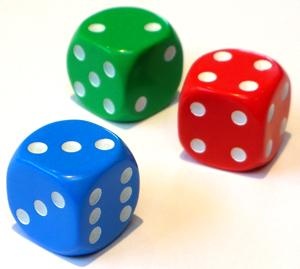We haven’t quite hit the 100-comment mark on the second Polymath 12 blog post, but this seems like a good moment to take stock. The project has lost some of its initial momentum, perhaps because other priorities have intruded into the lives of the main participants (I know that this is true of myself). However, I don’t want to turn out the lights just yet, because I don’t believe we’re actually stuck. Let me take this opportunity to describe some of the leads that I think are most promising.
Online Version of Conjecture
For general matroids, the online version of Rota’s Basis Conjecture is false, but it is still interesting to ask how many bases are achievable. One of the nicest things to come out Polymath 12, in my opinion, has been a partial answer to this question: It is somewhere between n/3 + c and n/2 + c. There is hope that this gap could be closed. If the gap can be closed then in my opinion this would be a publishable short paper. Incidentally, if a paper is published by Polymath 12, what pseudonym should be used? I know that D. H. J. Polymath was used for the first project, but maybe R. B. C. Polymath would make more sense?
Graphic Matroids
It was suggested early on that graphic matroids might be a more tractable special case. It wasn’t immediately clear to me at first why, but I understand better now. Specifically, graphic matroids with no K4 minor are series-parallel and therefore strongly base-orderable and therefore satisfy Rota’s Basis Conjecture. Thus, in some sense, K4 is the only obstruction to Rota’s Basis Conjecture for graphic matroids, whereas the analogous claim for matroids in general does not hold.
In one of my papers I showed, roughly speaking, that if one can prove an n × 2 version of Rota’s Basis Conjecture, then this fact can be parlayed into a proof of the full conjecture. Of course the n × 2 version is false in general, but I do believe that a thorough understanding of what can happen in just two columns will give significant insight into the full conjecture. One question I raised was whether any n × 2 arrangement of edges can yield two columns that are bases if we pull out no more than n/3 edges. This is perhaps a somewhat clumsy question, but it is trying to get at the question of whether there are any n × 2 counterexamples that are not just the disjoint union of copies of K4 that have been expanded by “uncontracting” some edges. If we can classify all n × 2 counterexamples then I think that this would be a big step towards proving the full conjecture for graphic matroids.
This is of course not the only possible way to tackle graphic matroids. The main point is that I think there is potential for serious progress on this special case.
Computational Investigations
I mentioned an unpublished manuscript by Michael Cheung that reports that the n = 4 case of Rota’s Basis Conjecture is true for all matroids. I find this to be an impressive computation and I think it deserves independent verification.
Finding 5 × 2 counterexamples to Rota’s Basis Conjecture would also be illuminating in my opinion. Gordon Royle provided a link to a database of all nine-element matroids that should be helpful. Luke Pebody started down this road but as far as I know has not completed the computation.
Strongly Base-Orderable Matroids
In 1995, Marcel Wild proved the following result (“Lemma 6”): Let  be a matroid on an
be a matroid on an  -element set
-element set  that is a disjoint union of
that is a disjoint union of  independent sets
independent sets  of size
of size  . Assume that there exists another matroid
. Assume that there exists another matroid  on the same ground set
on the same ground set  with the following properties:
with the following properties:
(1)  is strongly base orderable.
is strongly base orderable.
(2)  for all
for all  , where
, where  is the rank function of
is the rank function of  .
.
(3) All circuits  of
of  satisfying
satisfying  remain dependent in
remain dependent in  .
.
Then there is an  grid whose
grid whose  th row comprises
th row comprises  and whose columns are independent in
and whose columns are independent in  .
.
Wild obtained several partial results as a corollary of Lemma 6. How much mileage can we get out of this? Can we always find a suitable  for graphic matroids?
for graphic matroids?
Variants and Related Conjectures
I’m less optimistic that these will lead to progress on Rota’s Basis Conjecture itself, but maybe I’m wrong. Gil Kalai made several suggestions:
- Consider d + 1 (affinely independent) subsets of size d + 1 of
 such that the origin belongs to the interior of the convex hull of each set. Is it possible to find d + 1 sets of size d + 1 such that each set is a rainbow set and the interior of the convex hulls of all these sets have a point in common?
such that the origin belongs to the interior of the convex hull of each set. Is it possible to find d + 1 sets of size d + 1 such that each set is a rainbow set and the interior of the convex hulls of all these sets have a point in common?
- The wide partition conjecture or its generalization to arbitrary partitions.
- If we have sets B1, …, Bn (not necessarily bases) that cannot be arranged so that all n columns are bases, then can you always find disjoint n + 1 sets C1, …, Cn+1 such that each set contains at most one member from each Bj and the intersection of all linear spans of the Ci is non trivial? (I confess I still don’t see why we should expect this to be true.)
Pavel Paták presented a lemma from one of his papers that might be useful. Let M be a matroid of rank r and let S be a sequence of kr elements from M, split into r subsequences, each of length at most k. Then any largest independent rainbow subsequence of S is a basis of M if and only if there does not exist an integer s < r and set of s + 1 color classes, such that the union of these color classes has rank s.
In a different direction, there are graph-theoretic conjectures such as the Brualdi–Hollingsworth conjecture: If the complete graph K2m (for m ≥ 3) is edge-colored in such a way that every color class is a perfect matching, then there is a decomposition of the edges into m edge-disjoint rainbow spanning trees.
Remarks on Previous Blog Post
Finally, let me make a few remarks about the directions of research that were suggested in my previous Polymath 12 blog post. I was initially optimistic about matroids with no small circuits and I still think that they are worth thinking about, but I am now more pessimistic that we can get much mileage out of straightforwardly generalizing the methods of Geelen and Humphries, for reasons that can be found by reading the comments. Similarly I am more pessimistic now that the algebro-geometric approach will yield anything since being a basis is an open condition rather than a closed condition.
The other leads in that blog post have not been pursued much and I think they are still worth looking at. In particular, that old standby, the Alon–Tarsi Conjecture, may still admit more partial results. Rebecca Stones’s suggestion that maybe Lneven – Lnodd ≢ 0 (mod p) when p = 2n + 1 is prime still looks to me like a good idea and I don’t think many people have seriously thought about this. Also I agree with David Glynn that more people should study Carlos Gamas’s recent paper on the Alon–Tarsi Conjecture.



